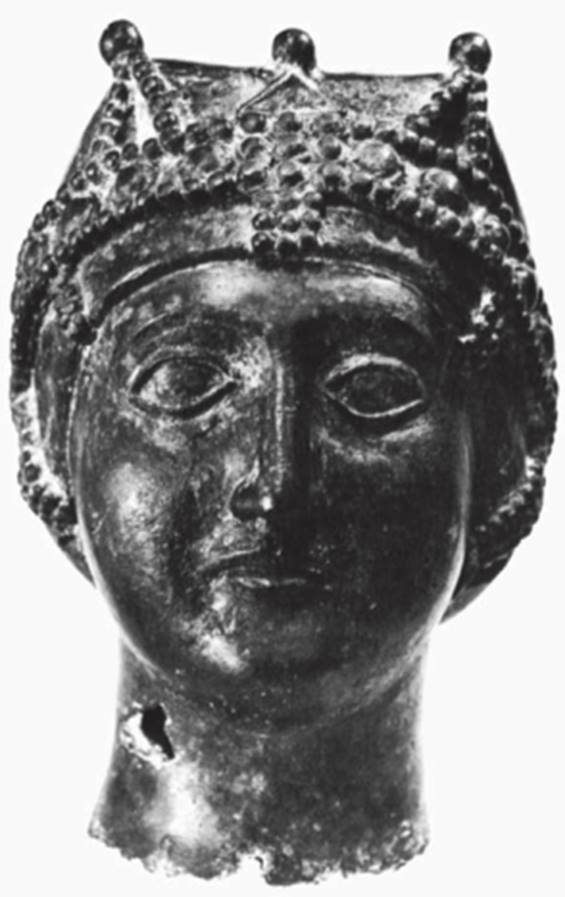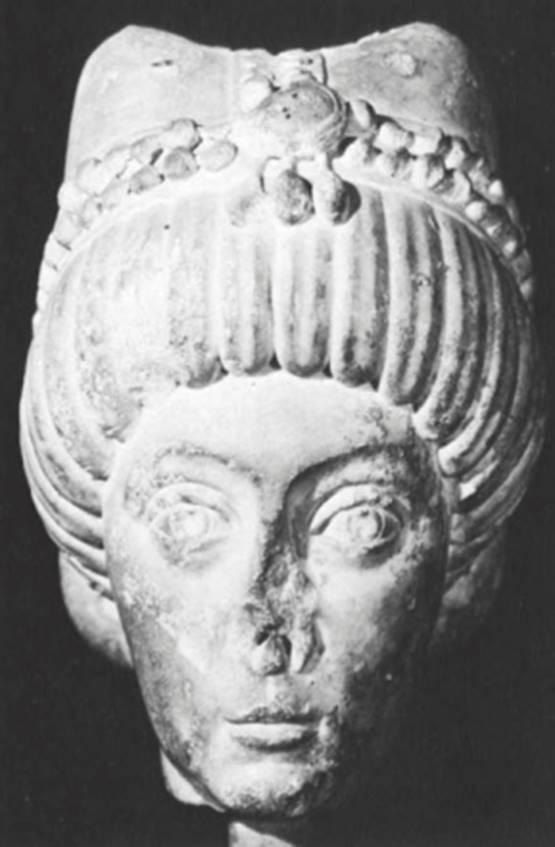Head of Euphemia. Constantinople (?), about 520-530. Bronze
The bronze head was made for insertion in full- length statue of about life-size. In good condition, it shows normal surface corrosion, but broken edges at base and one hole in right side of neck. Slot behind ear(s ?) may have been for the insertion of an earring. The subject is a youngish-looking woman, wearing imperial headdress, with smooth generalized features, little detail, and irises indicating straightforward gaze.

The coiffure is similar, but not identical, to that of Ariadne (nos. 24, 25). As with no. 24, only earlobes protrude beneath the bonnet, but no hoops traverse the top of the hair. The diadem, which has jewels in its central band and three triangular projections at the front, links the portrait with the empresses of the early sixth century (see Wessel, 1962). The uniformly textured surfaces and spherical overall shape, which is even more compact than in the Ariadne images, also date the head to this period. The handling of the eyelids is more summary than in the Ariadne heads, and suborbital pouches are absent.
If the subject cannot be Ariadne, neither does it resemble the known portraits of Theodora (see no. 27). The likeliest identification, then, is with the empress Euphemia, although she was, like her consort, Justin I, of advanced years when she reached the throne. The head is surely an idealized image, probably made for a dedication (with one of Justin) in the forum of the provincial city where it was discovered.
The head was excavated in 1958 at the site of Kulina, at Balajnac in Yugoslavia.
Head of Theodora. Constantinople (?), about 530-540. Marble. The neck is broken off below chin; nose broken, and numerous chips and scratches mar surfaces, especially right cheek, both eyes, right front of coiffure, and various jewels and pearls in crown. A slender-faced woman of mature years looks straight ahead; her large eyes have incised irises and drilled pupils, with crisply cut eyelids under broad, arching brows. Mouth, cheeks, and chin are delicately modeled.

The headdress is an advanced version of the style initiated by Ariadne (nos. 24, 25; see Wessel, 1962), with the diadem binding a snooded coiffure, and is called the “melon" type. It is taller than that of nos. 24, 25, or 26, with the diadem high off the brow, and the entire mass balanced farther back on the head. The three hoops of pearls over the cap are all longitudinal, with only the central one a double row. The diadem itself has two rows of pearls and an elaborate central jewel with three pendants; it is tied behind with an elaborate knot.
The Western provenance of this head, and certain superficial similarities to such works as the Aelia Flacilla in Paris (no. 20) or the Barletta colossus (no. 23), have led to widely varied identifications, most recently as Galla Placidia (von Heintze, 1971). Sande (1975) states that this attribution is weakly based on comparisons with partly doubtful works, while the form of crown did not appear before 500.
The compact form and the contrast of delicately worked surfaces with the geometrical composition conform with our evidence for sixth-century sculptural style. The physical similarities between this face and that of the mosaic portrait of Theodora in S. Vitale, Ravenna (no. 66)—and the descriptions of Theodora given by the contemporary chronicler Procopius [Anecdota 10.11)—make the identification of this head as a portrait of that empress all but certain. Subtle as the differences are, comparison of this head with that of Ariadne (no. 24) shows that early Byzantine portraitists could, when challenged by a sufficiently interesting sitter, achieve likenesses that are convincing not only as to physical similarity but psychological truth as well.
The head was discovered during demolition of the medieval walls of Milan.
Bibliography: Delbrueck, 1913, pp. 310-318, passim; Wessel, 1962; von Heintze, 1971, no. vi, fig. 7; Sande, 1975, pp. 93-97.
Date added: 2025-07-10; views: 185;
